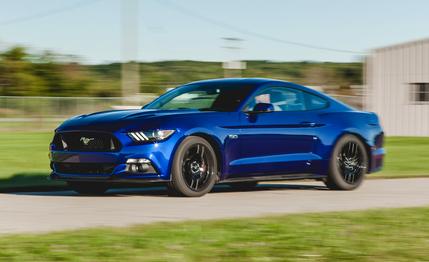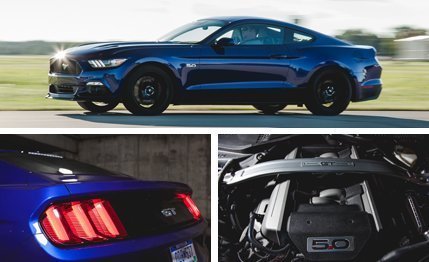
 Instrumented Test
Instrumented Test
With the new Ford Mustang finally sitting before us, a walkaround is the first order of business. Circling the newest pony, there’s no mistaking it for anything but a Mustang. The all-new 2015 model retains the right proportions, with a long hood, a compact and low greenhouse, and an extremely fast, well, fastback roofline. Strong cheekbones and taut sheetmetal enhance its beauty, while jawlines on top of jawlines will convey an appropriate sense of terror to anyone who encounters one in their rearview mirror.
Sliding behind the wheel, we begin to experience some nervousness—on behalf of the car. You see, this isn’t the four-cylinder turbocharged EcoBoost model, or even the rental-counter base V-6. No, what we have here is what some might refer to as the real Mustang: the V-8 GT. More than any other 2015 Mustang, it carries the weight of expectations. Heavy expectations. Yes, the direct-injected EcoBoost is a technologically advanced engine and its turbocharger forces enough air through it to embarrass many eight-cylinders from a decade ago, but it still isn’t a proper V-8, no matter how much power it makes or how efficient it is.


READ MORE: 2015 Ford Mustang Engines: What You Need to Know
As for the V-8, it’s a worked over version of the outgoing Mustang’s Coyote powerplant, more specifically a version that saw the stonking Boss 302 serve as its drivability and output bogey. Certified on 93-octane unleaded, horsepower now stands at 435 (up from 420) and torque comes in at a nice, even 400 lb-ft. According to the EPA, fuel will be burned at a rate of 15 mpg in the city and 25 on the highway with the six-speed manual; the six-speed automatic does one better in the city. We saw 17 mpg from this stick-shift car. If you fill up using 87 octane, you’ll be down on horsepower—by about one percent according to Ford. So it’s highly unlikely you’ll notice.
With a six-speed manual sprouting up between the seats, the V-8 makes very short work of the first three gears. The accelerative rush is such that the somewhat cheesy “Ground Speed” label on the speedometer makes some sense, and the needle swings into triple digits very quickly. Zero to 60 mph is accomplished in 4.5 seconds and the quarter-mile lights tripped in 13 flat; our Mustang also hit 150 mph in well under 30 seconds. Also, there’s no Muzak version of the Daytona 500 played through the speakers in the Mustang: The GT’s V-8 soundtrack, although more subdued than we expected, is generated solely by combustion events and not electrons. We came away from this hushed GT thinking about refinement, not tinnitus.
The refinement extends to the ride and handling. Even with the 19-inch wheels and Pirelli P Zeros that come with the GT Performance package—which also brings a bunch of bracing, uprated brakes, and much more; full details here—the ride feels like a slightly more supple Boss 302. Some credit must go to the new integral-link independent rear suspension; dropping the solid rear axle is the Mustang’s big leap out of its 1960s roots. Ford had managed over the years to massage the stick axle to acceptability—and near-transcendence in the case of the Boss—but untying the Mustang’s rear wheels from each other pays massive dividends in terms of impact mitigation and keeps the front and rear ends working more closely together. Setting the Mustang into a corner no longer puts you into the awkward situation of serving as a couples’ counselor to the fore and aft axles. Turn-in felt natural in the outgoing Mustang, but the rear end seemed slightly disconnected, as if it wasn’t sure it wanted to follow the front. Cornering is now secure and flat, and we measured 0.95 g of lateral grip with those sticky P Zeros. The new Mustang’s chassis is in total harmony.


READ MORE: How We’d Spec It: The Perfect 2015 Ford Mustang
It’s not just the chassis that feels right. The precise steering is electrically assisted, but the sensations are richly analog and not digital. (This is true in any of its three adjustable modes, which largely alter weight.) The Getrag-sourced six-speed manual shifts easily and slots into gear quickly, and it feels more polished than before. It’s no trouble to find a good seating position, the forward view is quite good, and the optional $1595 Recaro seats seem tailor-made just for you. The interior design gets a little inspiration from the previous generation, but the materials are vastly improved and the switchgear wears aluminum-look brightwork. The back seats remain strictly for kids, which is a bit disappointing given the Mustang’s 188.3-inch total length—within an inch of a Toyota Camry.
Unlike the Camry, though, the new Mustang GT is a whole mess of fun. Large doses of maturity and refinement have entered the equation, sure, but they make for an improved and more well-rounded whole. The 2015 Mustang handles better, it’s easier to live with, and it acts like a more expensive car. At its $45,885 as-tested price, the GT should behave like it knows its way around a monocle and top hat, and it does. The V-8 version does start at $32,925, but options drive it past $35,000 with ease. Enthusiasts who crave a louder and prouder Mustang can look to the forthcoming GT350, which likely will pack a high-revving V-8 and even more horsepower. For those who want to drive their Mustang every day for the next five years, however, the new GT delivers performance without brutality.